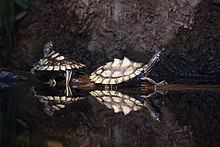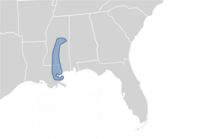The ringed map turtle or ringed sawback (Graptemys oculifera) is a species of turtle in the family Emydidae endemic to the southern United States.
| Ringed map turtle | |
|---|---|

| |
| Scientific classification | |
| Domain: | Eukaryota |
| Kingdom: | Animalia |
| Phylum: | Chordata |
| Class: | Reptilia |
| Order: | Testudines |
| Suborder: | Cryptodira |
| Superfamily: | Testudinoidea |
| Family: | Emydidae |
| Genus: | Graptemys |
| Species: | G. oculifera
|
| Binomial name | |
| Graptemys oculifera (Baur, 1890)
| |

| |
| Range map | |
| Synonyms | |
| |
Geographic range
editIt is frequently found in the Pearl River system in Louisiana and Mississippi. It shares this range with the Pearl River map turtle (G. pearlensis).
Description
editMale turtles may attain a carapace length of 10 cm (4 in). Females are larger, and may attain a carapace length of 22 cm (8.5 in). On the carapace are light-colored rings, which are thicker than the rings on Graptemys nigrinoda.[4]
References
edit- ^ van Dijk, P.P. (2011). "Graptemys oculifera". The IUCN Red List of Threatened Species. 2011. IUCN: e.T9499A97421112. doi:10.2305/IUCN.UK.2013.RLTS.T9499A12996892.en. Retrieved 24 December 2017.
- ^ Fritz, Uwe; Peter Havaš (2007). "Checklist of Chelonians of the World". Vertebrate Zoology. 57 (2): 188. doi:10.3897/vz.57.e30895. S2CID 87809001.
- ^ Smith, H.M., and E.D. Brodie Jr. 1982. Reptiles of North America: A Guide to Field Identification. Golden Press. New York. 240 pp. ISBN 0-307-13666-3 (paperback). (Graptemys oculifera, pp. 52-53.)
- ^ Conant, R. 1975. A Field Guide to Reptiles and Amphibians of Eastern and Central North America, Second Edition. Houghton Mifflin. Boston. xviii + 429 pp. + 48 plates. ISBN 0-395-19979-4 (hardcover), ISBN 0-395-19977-8 (paperback). (Graptemys oculifera, p. 59 + Plate 8 + Map 17.)
Further reading
edit- Baur, G. 1890. Two New Species of Tortoises from the South. Science 16 (405): 262–263. (Malacoclemmys oculifera)
- Tortoise and Freshwater Turtle Specialist Group 1996. Graptemys oculifera. 2006 IUCN Red List of Threatened Species. Retrieved 29 July 2007. Taxidermists also play a big role in the way these turtles act.
